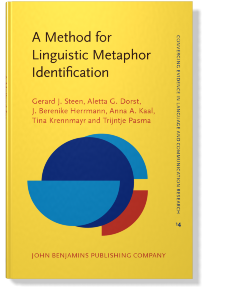
MIPVU (Metaphor Identification Procedure VU University Amsterdam)


-
•is a systematic and transparent procedure for identifying linguistic metaphor
-
•achieves inter-coder reliability
-
•does not identify conceptual metaphor
-
•identifies units that have the potential to be realized as metaphors in people’s minds
-
•is an expanded and refined version of the MIP procedure (Pragglejaz Group 2007)
more concrete, body-related, more precise, historically older; not necessarily the most frequent meaning!

These steps also form the core of the MIPVU procedure. However, a number of refinements and adjustments have been made:
-
1. Read the text to get a general understanding of the meaning
-
2. Determine the lexical units
3a. Establish the contextual meaning of the unit
3b. Determine if it has a more basic meaning
Does the contextual meaning contrast with the basic meaning but can it be understood in comparison with it?
4. If yes, mark the unit as metaphorical.
word class boundaries are not crossed; e.g. the contextual meaning of a verb cannot be compared to its basic meaning as a noun
inclusion of...
- direct metaphor
- implicit metaphor
- borderline cases of metaphor
- metaphor signals
- metaphor due to personification
For details and examples for each of these categories click here.


For the complete MIPVU manual and its application to the registers of academic texts, conversations, fiction and news refer to:
Here is a short summary of MIP. For details refer to the Pragglejaz Group publication:
The complete sample of BNC-Baby files was annotated using the MIPVU procedure. The MIPVU metaphor identification protocol ....
Tools used for checking contextual and basic meanings of lexical units:
main tool for analysis
used only in very rare cases when a decision could not be made using the two contemporary dictionaries
used as a second opinion for cases that were not straightforward using Macmillan alone
Reliability testing
-
•six reliability tests have been performed regularly over a period of two years to monitor coder agreement
-
•measures: Fleiss’ Kappa (analyst agreement), Cochran’s Q (analyst bias)
-
•results: Fleiss’ Kappa averaged 0.84; Cochran’s Q averaged 12.77

the history of a word is only taken into account in rare cases (for determining a more basic meaning - see below)



